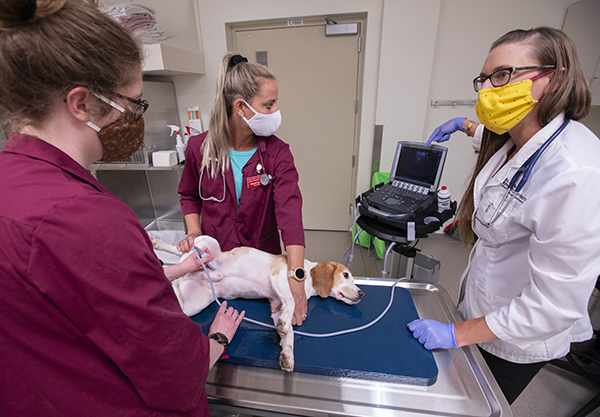
When students graduate from the College of Veterinary Medicine they are expected to be “practice-ready” – able to hit the ground running when they begin at their first professional veterinary position.
CVM faculty are constantly on the lookout for ways to improve that readiness for the real world. A team of faculty led by Dr. Jessica Ward, the Phyllis M. Clark Professor of Veterinary Cardiology and associate professor of veterinary clinical sciences, is making strides in one area.
Beginning this fall, diagnostic ultrasound instruction will be added to the college’s curriculum beginning in the second year of the four-year program. Students will receive basic instruction as part of the college’s core curriculum including directed training in the form of lectures and hands-on laboratories in the second-year Principles of Surgery course.
Ultrasound units will then be available in the college’s Clinical Skills Laboratory for continued practice by students, either independently or during faculty-led club wetlabs. Fourth-year students will use the technology in their clinical rotations.
“Ultrasound technology and its use have increased in popularity over the past two decades,” Ward said. “When the technology was first available, it was expensive and the equipment was large, so ultrasound was confined to the hands of specialists.”
The world of ultrasound has now changed dramatically. The equipment is now much smaller but perhaps more importantly the cost for devices has decreased, enabling small veterinary clinics the ability to purchase the technology.
As a result, clinics are looking for new graduates with basic ultrasound experience.
“Applications for ‘point-of-care’ ultrasound protocols have emerged throughout the industry,” Ward said. “Now general practitioners or emergency veterinarians can effectively use the technology to make clinical decisions and improve patient care.”
Ward is working with Iowa State clinicians in the Lloyd Veterinary Medical Center, the Clinical Skills Laboratory, and the Junior Surgery and Community Outreach Program. The group received a Excellence in Education grant from the College of Veterinary Medicine and additional funding from Hills Pet Nutrition and the school’s SAVMA chapter.
That funding has been used to purchase four ultrasound machines that will be used to implement this program.
“The goal is to give the second year students the basics of the technology,” Ward said. “Once they are equipped with those skills they can practice in their third year and take it to the next level during their clinical rotations.
“When the students graduate, they will be equipped with skills in a modality that is now considered a standard of care across veterinary disciplines. Whether they pursue small animal, food animal, equine or zoo and wildlife medicine, this program will help Iowa State students be practice-ready.”
July 2020
